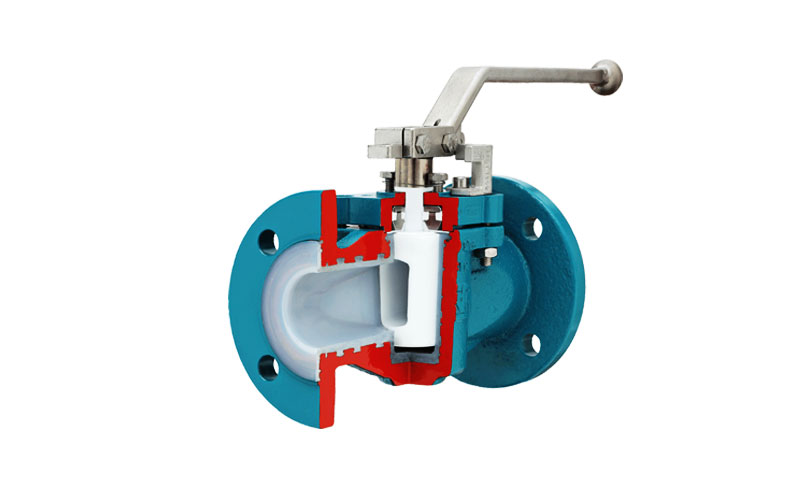1. Introduzzjoni
Plug valve is a versatile quarter-turn valve widely used for isolation, diversion, and occasional throttling in industrial systems.
Its simple design—a cylindrical or conical plug rotating within a valve body—offers fast operation, low-pressure drop, and robust reliability.
Understanding its principles, materjali, Metriċi tal-Prestazzjoni, and industrial applications is essential for selecting the right valve for high-pressure, Abrasiva, or space-constrained services.
2. X'inhu valv tal-plagg?
A plug valve is a specialized quarter-turn rotary valve widely utilized in industrial piping systems for flow isolation, diversion, and occasional throttling.
The core operating principle relies on a cylindrical or conical plug housed within a valve body, which rotates to either align its internal port with the pipeline for unrestricted flow or to block the passage completely.
This simple yet robust mechanism allows rapid 90° operation, offering both efficiency and reliability in critical applications.
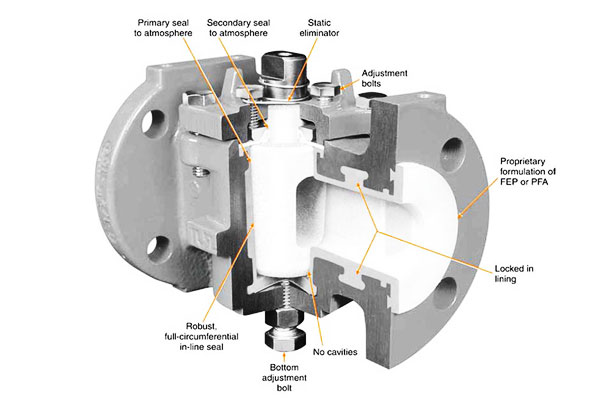
Core Features
- Quarter-turn Operation
Fast actuation (typically 90°) — ideal for emergency isolation, diverter duties and applications where rapid on/off action is required. - Sempliċi, Low-Obstruction Flow Path
Full-port configurations provide virtually pipe-bore flow with minimal pressure drop; reduced-port options trade flow capacity for lower torque and cost. - Multiple Port Configurations
Two-, three- and four-way plug arrangements allow diversion, Taħlit, sampling and complex routing without multiple valves. - Sealing Versatility
Available with metal-to-metal seats for high-temperature/abrasive services, Resiljenti (PTFE / rptfe, Elastomeri) seats for bubble-tight shutoff and low torque, jew lubricated systems that extend seat life in dirty or erosive media.
3. Classification of Plug Valves by Design
Plug valves are categorized based on Disinn mekkaniku, Metodu tas-siġillar, and flow configuration.
Understanding these classifications helps engineers select the right valve for pressure, temperatura, fluss, and service requirements.
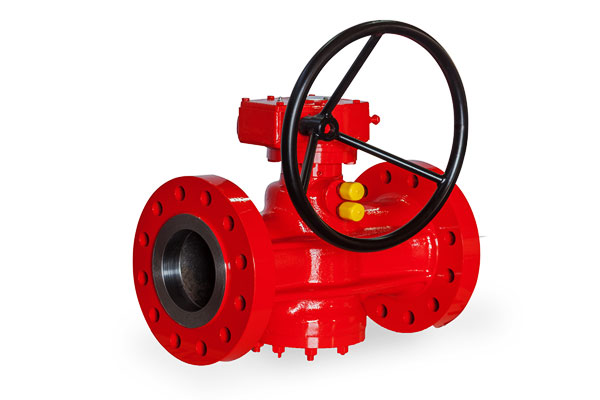
Based on Plug Type
| Tip | Deskrizzjoni | Vantaġġi | Applikazzjonijiet tipiċi |
| Cylindrical Plug Valve | Straight cylindrical plug rotates inside a matching body cavity; simplest design. | Kompatt, kosteffikaċi, low-pressure drop. | Ilma, gass, low-pressure chemical lines. |
| Conical (Tapered) Plug Valve | Conical plug wedged into the body for tighter sealing. | Excellent sealing; handles higher pressure and temperature. | Petrokimiċi, żejt & gass, Linji tal-fwar. |
Based on Port Configuration
| Port Type | Deskrizzjoni | Vantaġġi | Applikazzjonijiet tipiċi |
| Through Port (Full Port) | Port matches pipeline diameter; flow path straight through. | Waqgħa minima ta 'pressjoni; high-flow capacity. | Bulk fluid transport, pajpijiet, slurry handling. |
| Reduced Port | Port smaller than pipe bore. | Lower operating torque; kost-effiċjenti. | Moderate-flow systems, instrument lines. |
| Multi-Ports (Three- or Four-Way) | Allows flow diversion, Taħlit, or sampling through multiple ports. | Replaces multiple valves; flexible routing. | Sampling, diverter duties, reatturi kimiċi. |
Based on Plug Support
| Support Type | Deskrizzjoni | Vantaġġi | Limitazzjonijiet |
| Floating Plug | Plug rests between seats and rotates freely. | Self-aligning; simple construction. | Higher torque on large sizes; limited high-pressure use. |
| Trunnion-Mounted Plug | Plug anchored with top and/or bottom bearings. | Reduces operating torque; stable in high-pressure or large-size applications. | Disinn aktar kumpless; spiża ogħla tal-manifattura. |
Based on Sealing Design
Extended seat life; smooth operation in dirty or erosive fluids.
Periodic maintenance; not ideal for sanitary applications.
lymer seats provide tight sealing.
| Sealing Type | Deskrizzjoni | Vantaġġi | Limitazzjonijiet |
| Metal-to-Metal | Hard seat directly contacts plug. | Temperatura għolja, pressjoni għolja, abrasive service. | Requires higher torque; potential for galling without lubrication. |
| Resilient Seats (Ptfe, Rptfe)
</td> |
Elastomer or po | Low torque; bubble-tight shutoff; Reżistenza kimika. | Limited temperature range; potential degradation with aggressive media. |
| Lubr |
4. Main Components and Materials of Plug Valve
A plug valve’s performance, Durabilità, and suitability for specific applications depend on its components and materials.
Each part is engineered to withstand pressure, temperatura, korrużjoni, and erosion while ensuring smooth operation and leak-tight sealing.
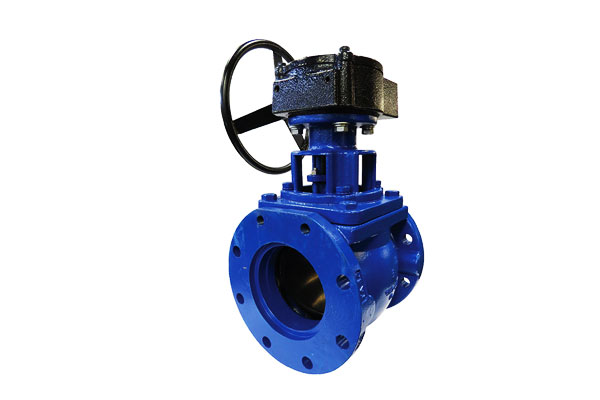
Main Components
| Komponent | Deskrizzjoni | Funzjoni |
| Korp tal-valv | The external housing that contains the plug and ports. | Supports pressure loads, provides the flow path, and connects to the pipeline. |
| Plagg | Cylindrical or conical rotating element with one or more ports. | Controls flow by aligning or blocking the port(s); primary flow-control element. |
| Siġġijiet | Metal or resilient surfaces against which the plug seals. | Ensures bubble-tight shutoff and maintains long-term sealing integrity. |
| Zokk / Handle | Shaft or lever used to rotate the plug. | Transfers torque from manual or automated actuator to plug. |
| Lubricant Chamber (mhux obbligatorju) | A reservoir between plug and body filled with lubricant (for lubricated plug valves). | Reduces friction, prolongs seat life, and prevents galling or corrosion. |
| Bearings / Trunnions (for trunnion-mounted plugs) | Supports at top and/or bottom of plug. | Reduces operating torque and stabilizes the plug in large or high-pressure valves. |
| Glandola / Ippakkjar | Sealing element around the stem or handle interface. | Prevents leakage along the stem/handle; allows smooth rotation. |
Materials Selection
| Komponent | Materjali tipiċi | Propjetajiet ewlenin |
| Korp & Bonit | Azzar tal-Karbonju (A216 WCB), Stainless Steel (304, 316), Duplex, Liga 20, Ligi tan-nikil | Saħħa, Reżistenza għall-korrużjoni, Tolleranza tat-temperatura |
| Plagg | Same as body or hardfaced (Stellite, WC overlay) | Reżistenza għall-ilbies, Stabbiltà dimensjonali, Kompatibilità kimika |
| Siġġijiet | Metall (Stellite, Monel), PTFE / rptfe, UHMWPE | Sealing tightness, Reżistenza kimika, frizzjoni baxxa |
| Zokk / Handle | Stainless Steel, Azzar tal-liga | Saħħa, Riġidità torsjonali, Reżistenza għall-korrużjoni |
| Lubricant | Mineral oil, synthetic grease, or FDA-approved lubricants | Reduces friction and protects against corrosion in lubricated valves |
5. Flow characteristics and hydraulic behavior

Flow capability (Cv) — typical ranges
- Small instrument-sized plug valves (¼ – 1) may have Cv ~ 0.1–5.
- Common process sizes (2–6) typically range Cv ~ 5–200 depending on port design (full port vs. reduced port).
- Large diameter plug valves (8+) can achieve very high Cv values, comparable to ball valves and often exceeding globe valves for the same size.
Pressure drop and throttling
- Plug valves are primarily designed for mixgħul / mitfi jew diverter servizz.
While they can be used for throttling, huma less ideal than globe valves for precise modulation because of potential nonlinear flow characteristics and seat wear when throttled under high ΔP. - Pressure drop increases with flow and decreases with port size; high ΔP service requires special trims (multi-stage or pressure-reducing plugs) to avoid noise and erosion.
6. Performance metrics and classes
| Metrika | Typical concern / firxa |
| Pressure class | ANSI 150–2500 common; higher with forged designs |
| Temperature range | Krijoġeniku (with suitable materials) up to ≈400–600°C in common alloys; specialty alloys extend range |
| Tnixxija | Sedili tal-metall: low leakage but not bubble-tight in all cases; resilient seats: bubble-tight (practically zero leakage) |
| Cycle life | Lubricated metal seats: long life in clean service; resilient seats: thousands to tens of thousands of cycles |
| Fugitive emissions | Mitigate with bellows, live-loaded packing, and compliant stem seals |
| Standards & Testijiet | Shell/seat pressure testing, seat leakage testing, NDT on critical parts (Radjografija, MPI) |
7. Manufacturing Process of Plug Valve
The manufacturing of plug valves involves precise ikkastjar, magni, assemblaġġ, and testing to ensure durability, leak-tight sealing, and reliable operation under various industrial conditions.

Casting or Forging the Body and Plug
The valve body and plug form the structural core of the plug valve. They can be produced via:
- Ikkastjar tar-ramel: Common for medium- to large-sized valves. Provides flexibility in complex geometries, including multi-port bodies, and allows embedded features such as trunnion supports.
Post-casting heat treatment reduces residual stress. - Casting ta' Investiment (Xama 'mitlufa): Offers exceptional dimensional accuracy and smooth surfaces, ideal for precision or smaller valves with tight tolerances.
- Forġa: Jipproduċi dens, high-strength components for high-pressure or critical applications. Forged valves have fewer voids and superior fatigue resistance, suitable for API 6D pipeline standards.
Makkinar ta 'preċiżjoni
After casting or forging, Komponenti jgħaddu minnha CNC and manual machining to achieve exact tolerances and smooth surface finishes:
- Plug Boring and Grinding: Ensures the plug rotates freely while maintaining a tight seal against the seat.
- Seat Machining: Metal or resilient seats are machined to micron-level tolerances to ensure bubble-tight shutoff.
- Port Alignment: Critical for multi-port valves to guarantee correct flow paths and minimize pressure drop.
- Irfinar tal-wiċċ: Lapper, illustrar, or honing reduces friction, prevents galling, and improves long-term sealing reliability.
Hardfacing and Coatings
To enhance durability in Abrasiva, erosive, or corrosive media, plugs and seats may be:
- Hardfaced ma ' Stellite, karbur tat-tungstenu, or nickel-based alloys, increasing wear resistance and prolonging service life.
- Coated with corrosion-resistant layers such as PTFE, plating tan-nikil, or epoxy.
- Lubricated in specialized valves to maintain low torque operation, prevent galling, and extend seal life, particularly in high-pressure slurry applications.
Assembly and Fitment
Assembly is a precision operation that ensures proper allinjament, smooth actuation, and sealing integrity:
- Plug Insertion: Carefully placed in the body; lubricated if required.
- Stem and Trunnion Installation: Bearings and trunnion supports are fitted to reduce operating torque and stabilize large plugs under high pressure.
- Packing and Gland Adjustment: Prevents leakage along the stem while ensuring smooth rotation.
- Seal and Seat Verification: Metal or resilient seats are checked for correct compression, allinjament, and surface contact.
Ittestjar u Kontroll tal-Kwalità
Every plug valve undergoes rigorous testing to meet API, ISO, and ASTM standards:
- Hydrostatic and Pneumatic Pressure Tests: Validate body and seat integrity under rated working pressures and maximum allowable pressures.
- Seat Leakage Tests: Confirm bubble-tight closure according to ISO 5208 or API 598.
- Verifika dimensjonali: CNC coordinate measuring machines (Cmm) ensure conformance to design specifications.
- Operational Torque Measurement: Ensures smooth rotation without excessive force, critical for automated or remote-actuated valves.
- Ittestjar mhux distruttiv (Ndt): Techniques such as dye penetrant, partiċella manjetika, or ultrasonic testing detect micro-cracks, porożità, or casting defects.
8. Vantaġġi u limitazzjonijiet
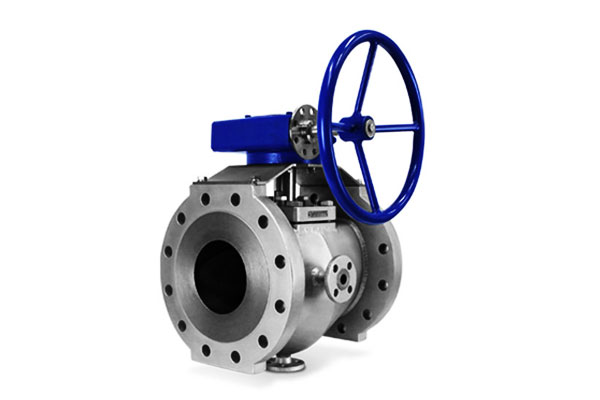
Key Advantages of Plug Valve
- Abrasive Fluid Resistance: Eccentric plugs with tungsten carbide seats last 300% longer than ball valves in mining slurries (per Mining Engineering Journal).
- Waqgħa ta 'pressjoni baxxa: Fully open plug valves reduce pump energy use by 10–15% vs. valvi tal-globu (EPA Energy Star data).
- Fast Operation: Quarter-turn design (0.5–2s for automated valves) – critical for emergency shutdowns (E.g., oil well blowouts).
- Versatilità: Handles liquids, gassijiet, and slurries across -196°C to 815°C – one valve type for multiple process streams.
- Prestazzjoni li ma tnixxix: Soft-seated valves achieve Class VI leakage (≤0.00001%) – prevents loss of expensive/toxic fluids.
Limitations of Plug Valve
- High Torque Requirements: Non-lubricated and metal-seated valves need 2–3x more torque than ball valves – larger valves require costly pneumatic/hydraulic actuators.
- Bżonnijiet ta 'manutenzjoni: Lubricated valves require quarterly grease injection – missed maintenance causes plug binding (downtime 4–8 hours per incident).
- High-Temperature Limits: Sedili artab (Ptfe) degrade above 260°C – limited to low-temperature service (E.g., Ipproċessar tal-ikel).
- Spiża: Eccentric and high-performance plug valves cost 20–50% more than ball valves – justified only for harsh conditions.
- Slurries with Large Solids: Multi-port and cylindrical plugs clog with solids >5 mm – require strainers or eccentric designs.
9. Application of Plug Valve
Plug valves excel in harsh industrial environments where other valves fail.
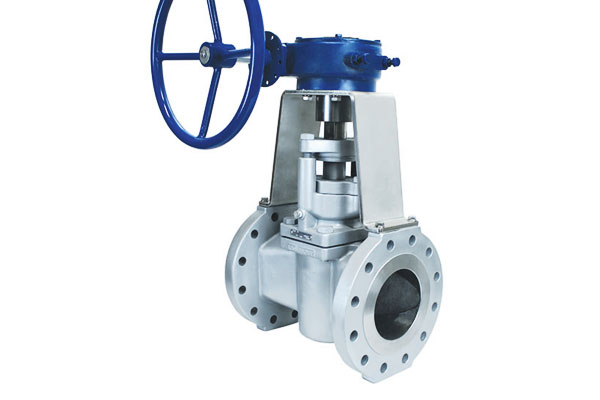
Below are key sectors and use cases:
Żejt & Gass
- Upstream (Wellheads): API 6A lubricated plug valves (1000 bar, 350° C.) regulate crude oil and sour gas – NACE MR0175 compliance resists H₂S corrosion.
- Midstream (Pajpijiet): Eccentric plug valves (6d nar) act as block valves for natural gas (flow rates up to 10,000 m³/h) – low pressure drop reduces compressor energy use.
- Downstream (Raffineriji): Metal-seated plug valves handle heavy oil and asphalt (400° C.) – Tungsten carbide plugs resist coke particle abrasion.
Water and Wastewater Treatment
- Sludge Handling: Eccentric plug valves (Sedili artab, Klassi VI) handle sludge with 20–30% solids – no clogging, 60% less downtime than ball valves.
- Chemical Dosing: Non-lubricated plug valves (Sedili PTFE) control chlorine/fluoride dosing – Class VI leakage prevents water contamination.
- Desalinizzazzjoni: 316L plug valves handle saltwater (538° C.) – corrosion resistance ensures 10+ year service life.
Chemical and Pharmaceutical
- Acid Processing: Hastelloy C276 plug valves handle 98% Aċidu sulfuriku (650° C.) – zero corrosion, Jiltaqa 'ma' ISO 15848-1 Class AH.
- Farmaċewtiċi: PTFE-lined plug valves (ASME BPE) regulate API dosing – Class VI leakage and CIP capability prevent cross-contamination.
Ġenerazzjoni tal-Enerġija
- Thermal Plants: Metal-seated plug valves control superheated steam (540° C., 200 bar) – used in turbine bypass systems.
- Nuclear Plants: 316L plug valves with metal bellows packing handle borated coolant – zero leakage (Klassi VI) prevents radiation release.
Mining and Minerals
- Slurry Transport: Eccentric plug valves (tungsten carbide seats) handle mining tailings (30% solidi) - 300% longer life than rubber-lined ball valves.
- Flotation Processes: Rubber-seated plug valves control froth flotation chemicals – low cost and easy maintenance for remote sites.
10. Comparison with Other Valves
Plug valves are one of several valve types used in industrial fluid control.
Understanding their relative strengths and limitations helps engineers select the most appropriate valve for a specific application.
The table below compares plug valves with other commonly used valves:
| Tip ta 'valv | Disinn & Operazzjoni | Vantaġġi ewlenin | Limitazzjonijiet | Applikazzjonijiet tipiċi |
| Plug Valve | Rotating cylindrical or conical plug with port; quarter-turn operation | Sempliċi, kumpatt, bubble-tight shutoff; low-pressure drop; versatile for multi-port flow | Manual operation torque can be high for large sizes; lubrication often required; Throttling limitat | Demel likwidu, żejt & gass, chemical process lines, diverting flow, teħid ta ’kampjuni |
| Valv tal-ballun | Spherical ball with bore; kwart-turn | Operazzjoni rapida; bubble-tight sealing; good for high-pressure/temperature; low torque | Limited multi-port configurations; not ideal for erosive media | Ilma, pajpijiet tal-gass, chemical lines, on/off applications |
| Valv tal-Bieb | Sliding gate between seats; linear motion | Waqgħa minima ta 'pressjoni meta tkun miftuħa għal kollox; bidirezzjonali; Adattat għal dijametri kbar | Operazzjoni bil-mod; Throttling fqir; bulky; potential vibration or chatter | Fwar, ilma, pajpijiet taż-żejt; isolation duties |
Valv tal-Globu |
Plug/seat or disc/seat linear motion; throttling design | Excellent flow regulation; Kontroll preċiż; robust sealing | Qatra ta 'pressjoni ogħla; aktar kumpless; operazzjoni aktar bil-mod; spiża ogħla | Kontroll tal-proċess, pjanti kimiċi, Ġenerazzjoni tal-Enerġija, throttling duties |
| Valv tal-farfett | Rotating disc; kwart-turn | Ħafifa, kumpatt; moderate throttling; kosteffikaċi għal dijametri kbar | Limited sealing tightness under high pressure; not suitable for abrasive fluids | HVAC, trattament tal-ilma, low-pressure chemical lines |
| Valv tal-labra | Tapered needle and seat; linear motion | Fine flow control; precise metering | Not for high flow; Operazzjoni bil-mod; small size | Strumentazzjoni, teħid ta ’kampjuni, laboratory applications |
Għarfien ewlieni:
- Prestazzjoni tas-siġillar: Plug valves provide bubble-tight shutoff similar to ball valves but can handle multi-port flow more efficiently.
- Throttling Capability: Linear valves like globe and needle valves excel in precise flow control; plug valves are better suited for on/off and diversion duties rather than fine throttling.
- Qatra pressjoni: Plug and ball valves have ΔP baxx in fully open positions; globe and gate valves can introduce significant pressure drop.
- Maintenance and Durability: Lubricated plug valves require regular inspection in abrasive or corrosive media; metal-seated plug valves provide long-term reliability in harsh conditions.
- Versatilità: Plug valves with multi-port configurations can replace several valves in diverter, mixer, or sampling systems, reducing piping complexity.
11. Konklużjoni
Plug valves are rugged, compact quarter-turn devices ideal for on/off, diverting and many isolation duties.
Their performance depends on careful selection of plug support (Floating vs Trunnion), seat type (metal vs resilient), materials and actuation.
They are not the best choice for precision throttling, but when fast action, simple construction and robust handling of dirty or abrasive fluids are required, plug valves are often the most practical solution.
Modern materials, coatings and digital actuators continue to expand their applicability.
Custom Valve Assemblies from LangHe
LangHe offerti custom valve assembly solutions, specializing in tailored components to meet specific industrial requirements.
Leveraging advanced casting, Magni ta 'preċiżjoni, and material expertise, LangHe provides plug valves, valvi ta 'kontroll, and other valve assemblies with:
- Custom Materials: Azzar tal-karbonju, azzar li ma jissaddadx, duplex, ligi tan-nikil, and high-performance materials for corrosive or high-temperature applications.
- Tailored Designs: Single-port, multi-port, lubricated, or metal-seated plug valves engineered to client specifications.
- Makkinar ta 'preċiżjoni: CNC-finished bodies and plugs with tight tolerances for smooth operation and leak-tight sealing.
- Assemblaġġ u ttestjar: Fully assembled valves, hydrostatically and functionally tested to meet ISO, API, or client standards.
LangHe’s customized services enable industries such as żejt & gass, Ipproċessar kimiku, trattament tal-ilma, u l-ġenerazzjoni tal-enerġija to integrate valves that meet unique operational, spatial, and performance constraints, ensuring reliability, effiċjenza, u ħajja twila ta 'servizz.
Contact LangHe today to design and manufacture valve components tailored to your exact specifications.
FAQs
What is the difference between a plug valve and a ball valve?
Plug valves use a cylindrical/tapered plug (eccentric designs reduce wear), while ball valves use a spherical ball.
Plug valves excel in abrasive/corrosive fluids (300% longer life in slurries), while ball valves are cheaper for non-abrasive, high-flow applications.
Which plug valve type is best for abrasive slurries?
Eccentric plug valves with tungsten carbide seats (85–90 HRC) are best.
The eccentric design lifts the plug off the seat (no sliding contact), and tungsten carbide resists wear from solids—extends life to 1–2 years vs. 3–6 months for ball valves.
How often should lubricated plug valves be lubricated?
Quarterly under normal service (żejt & gass, ilma); monthly for abrasive fluids (Minjieri). Automatic lubrication systems (pneumatic injectors) can extend intervals to 6–12 months.
Can plug valves handle high temperatures?
IVA. Metal-seated plug valves (Stellite 6, Hastelloy C276) handle up to 815°C (nuclear/power plants). Soft-seated valves (Ptfe) are limited to 260°C.
What is the leakage class of plug valves?
Soft-seated plug valves (PTFE/Viton) achieve ANSI FCI 70-2 Klassi VI (≤0.00001% leakage) – critical for toxic/expensive fluids.
Metal-seated valves achieve Class IV (≤0.01% leakage) – suitable for high-temperature service.
How do I reduce torque requirements for plug valves?
Use lubricated plugs (graphite-PTFE grease reduces friction by 50%); select eccentric designs (lifts plug off seat); ensure proper piping alignment (avoids binding).
